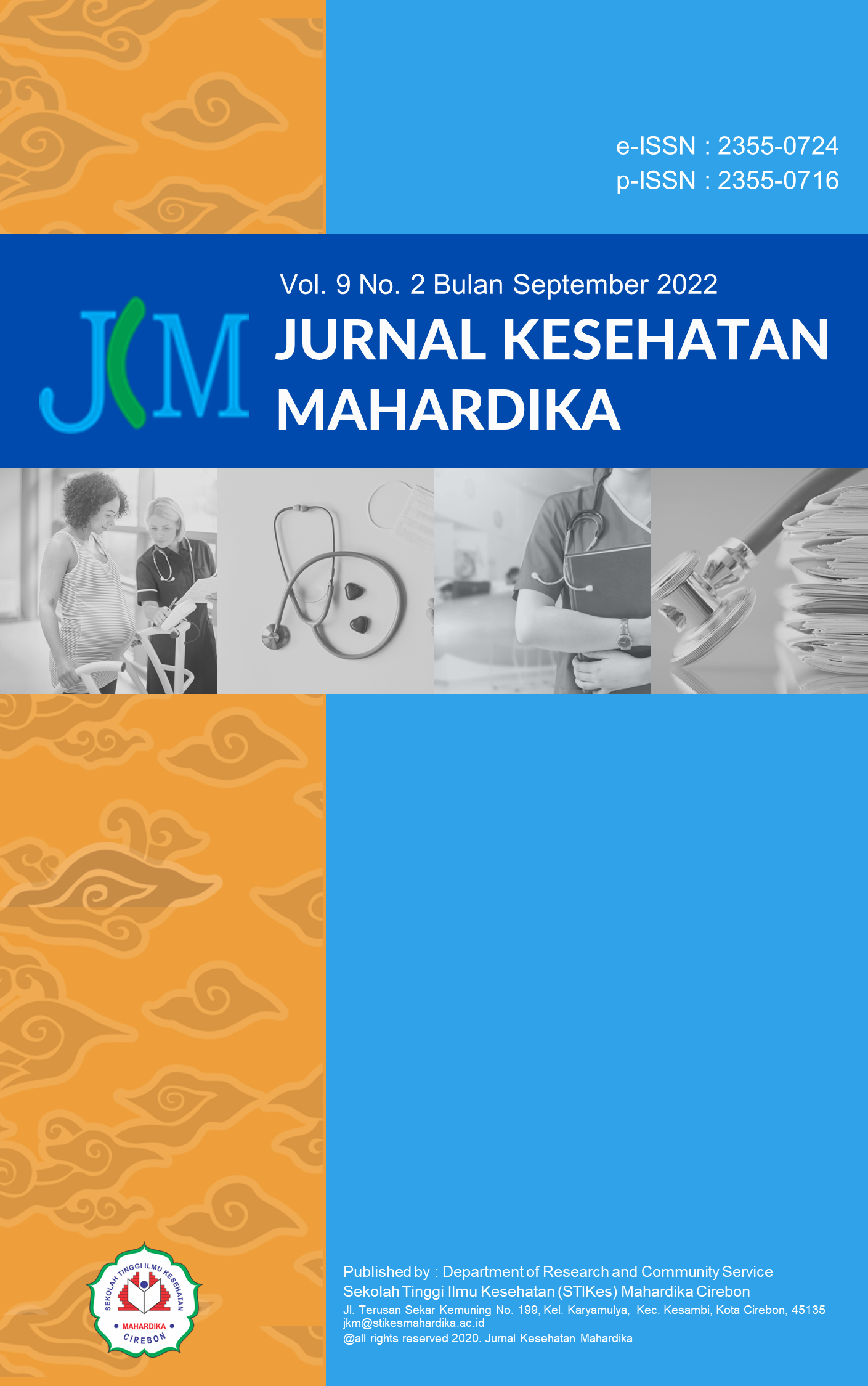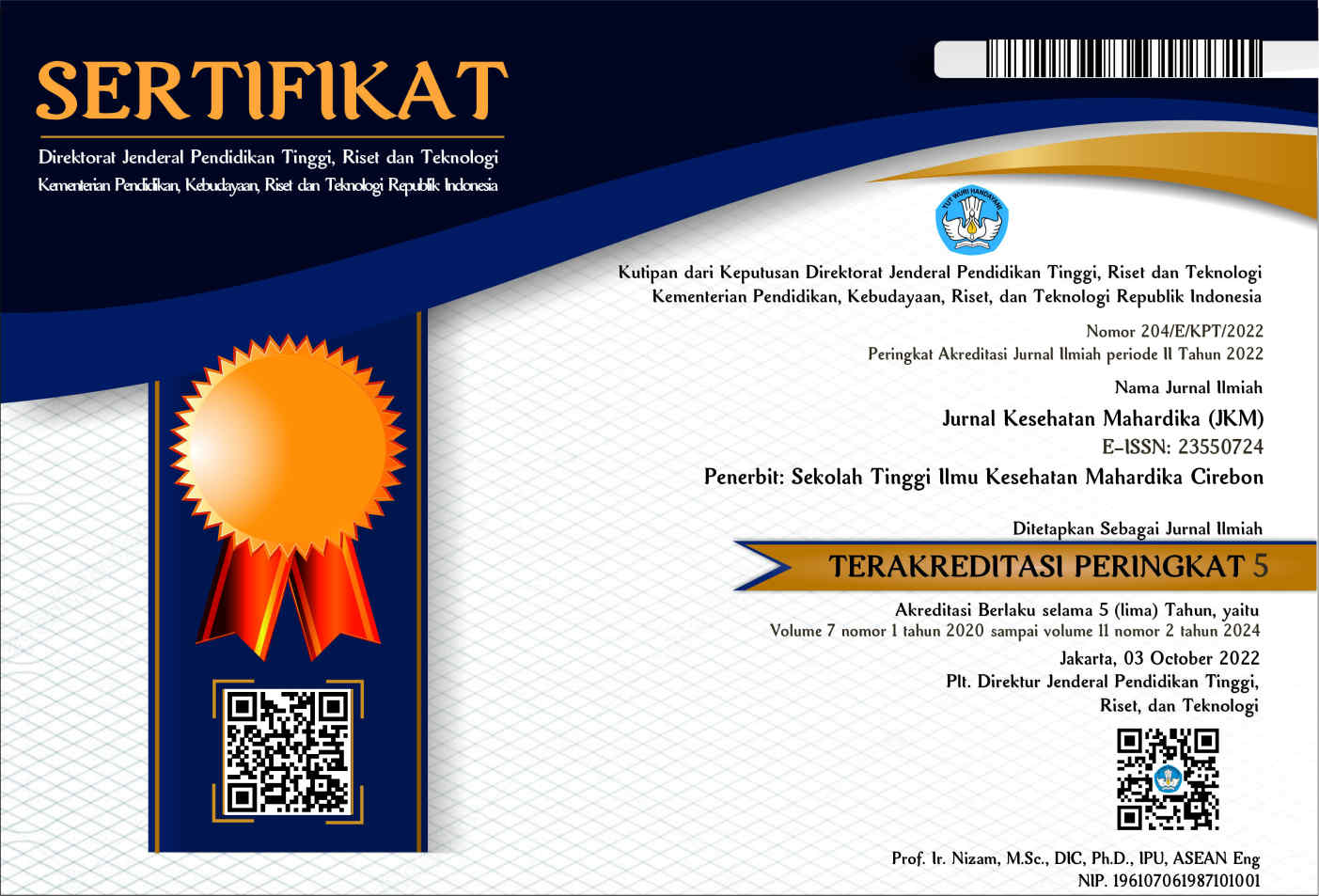A Narrative Review: Quintuple Helixs Model for Malaria Elimination in Indonesia
Keywords:
Malaria, Narrative Review, Quintuple HelixAbstract
Malaria continues to impact the health and economies of people around the world. Further steps need to be taken in accordance with the Global Technical Strategy for malaria to prevent malaria transmission. Quintuple helix model is an integrated effort that involves cross-sector in controlling malaria cases in an area. The implementation of the quintuple helix model is expected to be used as consideration and input for policy makers in an effort to achieve malaria elimination in Indonesia by 2030. The purpose of this study is to eliminate malaria in Indonesia with the quintuple helix model. This study uses a systematic review narrative method that is used to identify study topics selectively on interesting and recent issues. Malaria control in Indonesia is carried out using the national resilience approach. The results obtained from the academic aspect for malaria control must be met, both in terms of educational background qualifications, from the industrial aspect of the economic system included in the quintuple helix model, from the government aspect the control program must be compiled under the Ministry of Health, from the media aspect where the media is one of the an important index in the management of malaria in an area, and from an environmental aspect that aims to prevent, limit vector breeding and reduce mosquito contact with humans. The quintuple helix model is expected to be an innovation in malaria control in Indonesia. By involving academia and social community, industry, government, environmental engineering and the media. It is hoped that each sector can provide roles that are in accordance with their duties and functions
References
Organization WH. World Malaria Report 2020. 2020.
Organization WH. Malaria. 2021.
Organization WH. Global Technical Strategy Malaria 2016-2030. 2015.
Africa P, Germany P NA in cooperation with IP. Framework for strengthening Integrated Vector Management in malaria control programmes. 2013.
Indonesia KKR. Tren Kasus Malaria di Indonesia. 2021.
RI KK. Profil Kesehatan Indonesia Tahun 2018. 2019.
RI KK. Profil Kesehatan Indonesia. 2019.
Indonesia KKR. Malaria. 2020.
Keputusan Menteri Kesehatan Republik Indonesia Nomor 1405/Menkes/SK/XI/2002 tentang Persyaratan Kesehatan Lingkungan Kerja Perkantoran dan Industri. 2002.
Kementerian Kesehatan Republik Indonesia. Tantangan Menuju Eliminasi Malaria 2030. 2021;
Abegunde D, Orobaton N, Bassi A, Oguntunde O, Bamidele M AM. The Impact of Integrated Community Case Management of Childhood Diseases Interventions to Prevent Malaria Fever in Children Less than Five Years Old in Bauchi State of Nigeria. PLoS One. 2016;11(2):1–12.
Swana EK, Makan GY, Mukeng CK, Mupumba HI, Kalaba GM LO. Feasibility and implementation of community-based malaria case management with integrated vector control in the Democratic Republic of Congo. Malar J. 2016;15(1):1–14.
Astin N, Alim A ZZ. Studi Kualitatif Perilaku Masyarakat dalam Pencegahan Malaria di Manokwari Barat, Papua Barat, Indonesia. J Promkes. 2020;8(2):132.
Tynan A, Atkinson JA, Toaliu H, Taleo G, Fitzgerald L, Whittaker M, et al. Community participation for malaria elimination in tafea province, vanuatu: Part ii. Social and cultural aspects of treatment-seeking behaviour. Malar J [Internet]. 2011;10(1):204. Available from: http://www.malariajournal.com/content/10/1/204
Campbell DFJ, Carayannis EG, Rehman SS. Quadruple Helix Structures of Quality of Democracy in Innovation Systems: the USA, OECD Countries, and EU Member Countries in Global Comparison. J Knowl Econ. 2015;6(3):467–93.
Beier JC, Keating J, Githure JI, MacDonald MB, Impoinvil DE, Novak RJ. Integrated vector management for malaria control. Malar J. 2008;7(SUPPL. 1).
Keiser J, Singer BH, Utzinger J. Reducing the burden of malaria in different eco-epidemiological settings with environmental management: A systematic review. Lancet Infect Dis. 2005;5(11):695–708.
Michael E, Sharma S, Smith ME, Touloupou P, Giardina F, Prada JM, et al. Quantifying the value of surveillance data for improving model predictions of lymphatic filariasis elimination. PLoS Negl Trop Dis. 2018;12(10):1–26.
Gu W, Regens JL, Beier JC, Novak RJ. Source reduction of mosquito larval habitats has unexpected consequences on malaria transmission. Proc Natl Acad Sci U S A. 2006;103(46):17560–3.
Harijanto. Malaria: dari Molekuler ke klinis. Buku Kedok. Jakarta;
Smith KR, Woodward A, Campbell-Lendrum D, Chadee DD, Honda Y, Liu Q, et al. Human health: Impacts, adaptation, and co-benefits. Clim Chang 2014 Impacts, Adapt Vulnerability Part A Glob Sect Asp. 2015;709–54.
Gilroy AB, Chwatt LJ. Mosquito-control by swamp drainage in the coastal belt of nigeria. Ann Trop Med Parasitol. 1945;39(1):19–40.
Gyapong JO, Kumaraswami V, Biswas G, Ottesen EA. Treatment strategies underpinning the global programme to eliminate lymphatic filariasis. Expert Opin Pharmacother. 2005;6(2):179–200.
Breman JG, Mills A, Snow RW, Mulligan J, Lengeler C, Mendis K, et al. Chapter 21. Conquering Malaria. Dis Control Priorities Dev Ctries (2nd Ed. 2006;413–32.
Goodman C a, Coleman PG, Mills AJ. Economic Analysis of Malaria Control in Sub-Saharan Africa. Vol. 64, The Lancet. 2000. 109-167 p.
Goodman CA, Coleman PG, Mills AJ. Cost-effectiveness of malaria control in sub-Saharan Africa. 1999;354:378–85.
Mursid R, 2015, Global and Micro Climate Change Related to the Dynamics of Anopheles spIn Malaria-Endemic Area Purworejo City, Central Java, ICRPH, Makasar
Partz JA, Graczyk TK, Geller N, 2000,: Effects of environmental change on emerging parasitic diseases, Int J Parasitol, 30:1395-1405
Carayannis, E. G., Barth, T. D., Campbell, D. F. J. (2012) The Quintuple Helix Innovation Model: Global Warming as a Challenge and Driver for Innovation. Journal of Innovation and Entrepreneurship, 1(1): 1-12.
Morens DM: Confronting Vector-Borne Diseases in an Age of Ecologic Change. In Vector-Borne Diseases: Understanding the Environmental, Human Health, and Ecological Connections, Workshop Summary (Forum on Microbial Threats) Edited by: Lemon SM, Sparling PF, Hamburg MA, Relman DA, Choffnes ER, Mack A. Washington, D.C.: The National Academies Press; 2008:274-283.
Metcalf RL, Novak RJ: Pest-management strategies for insects affecting human and domestic animals. In Introduction to Insect Pest Management 3rd edition. Edited by: Metcalf RL, Luckman WH. John Wiley & Sons, Inc; 1994.
Protopopoff N, Van Herp M, Maes P, Reid T, Baza D, D'Alessandro U, Van Bortel W, Coosemans M: Vector control in a malaria epidemic occurring within a complex emergency situation in Burundi: a case study. Malar J 2007, 6:93.
Gu W, Novak RJ: Habitat-based modeling of impacts of mosquito larval interventions on entomological inoculation rates, incidence, and prevalence of malaria. Am J Trop Med Hyg 2005, 73:546-552.
Sharma VP, Sharma RC: Cost effectiveness of the bio environmental control of malaria in Kheda district, Gujarat. Indian J Malariol 1986, 23:141-145.
IPPC a,b,c, 2013, Ecosystem, Human Health, Intergovernmental Panel on Climate Change, Cambridge University Press, Cambridge

Published
How to Cite
Issue
Section
Copyright (c) 2022 Jurnal Kesehatan Mahardika

This work is licensed under a Creative Commons Attribution-NoDerivatives 4.0 International License.












